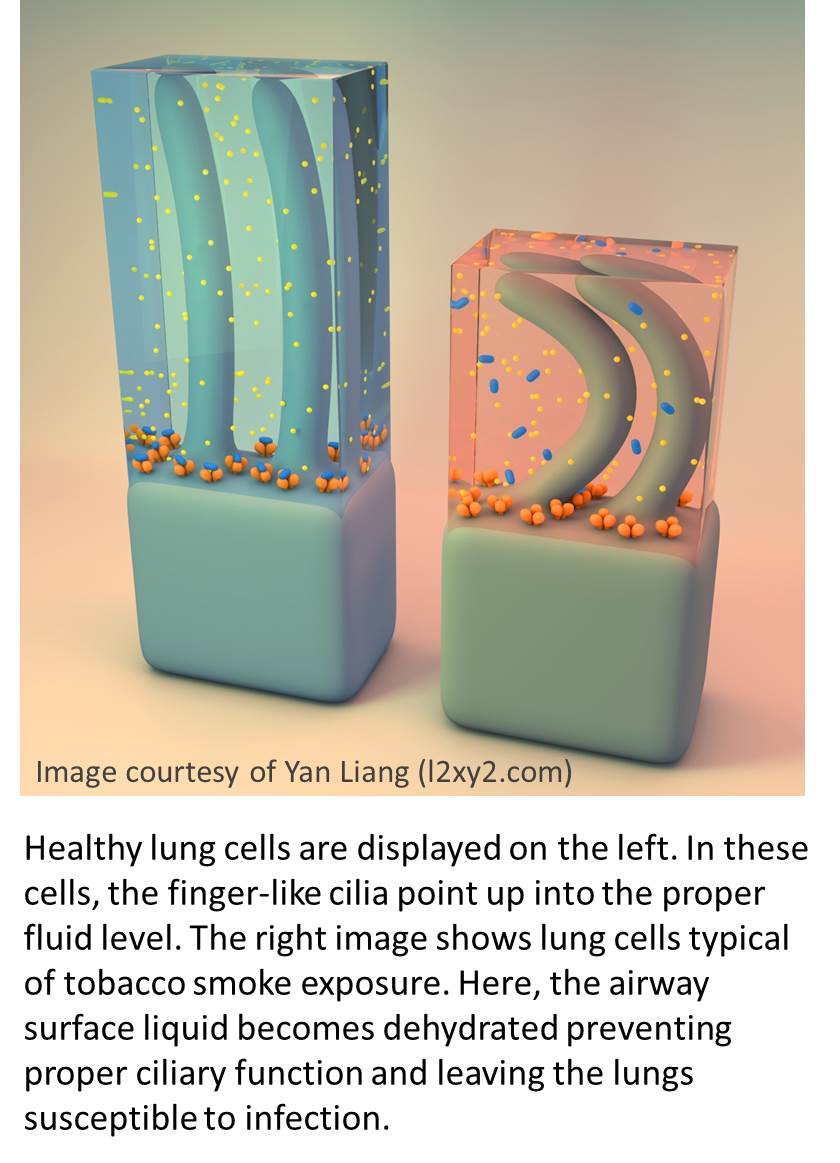Project I: The Effect of NETPs on Lung Hydration and Inflammation
 Multiple lines of evidence suggest that tobacco exposure negatively affects the lung’s innate defense system. This sets the stage for chronic inflammation, which can include cellular remodeling and activation of the unfolded protein response (UPR). Data has also recently emerged that indicates tobacco exposure alters the concentration of purines in airway surface liquid (ASL) and decreases cystic fibrosis transmembrane conductance regulator (CFTR) protein levels. As a result, rates of salt/water and mucin secretion become unbalanced. This likely causes ASL/mucus dehydration that reduces mucus clearance leading to impaired innate defense. Studies into this phenomenon have revealed that tobacco exposure triggers a rise in cytoplasmic Ca2+ which signals Cathepsin B secretion. When Cathepsin B reaches the extracellular environment, it then triggers CFTR internalization and hence, ASL dehydration. Importantly, knowledge of this pathway may reveal novel events that could be utilized as biomarkers of tobacco exposure.
Multiple lines of evidence suggest that tobacco exposure negatively affects the lung’s innate defense system. This sets the stage for chronic inflammation, which can include cellular remodeling and activation of the unfolded protein response (UPR). Data has also recently emerged that indicates tobacco exposure alters the concentration of purines in airway surface liquid (ASL) and decreases cystic fibrosis transmembrane conductance regulator (CFTR) protein levels. As a result, rates of salt/water and mucin secretion become unbalanced. This likely causes ASL/mucus dehydration that reduces mucus clearance leading to impaired innate defense. Studies into this phenomenon have revealed that tobacco exposure triggers a rise in cytoplasmic Ca2+ which signals Cathepsin B secretion. When Cathepsin B reaches the extracellular environment, it then triggers CFTR internalization and hence, ASL dehydration. Importantly, knowledge of this pathway may reveal novel events that could be utilized as biomarkers of tobacco exposure.
The first aim of this project is to determine which chemicals/toxins in tobacco smoke affect ASL nucleotide levels, ASL volume and UPR using human bronchial epithelial cultures. To accomplish this we will perform real time analysis of freshly produced smoke from cigarettes and NETPs (e.g., little cigars and hookah) to determine the concentration of toxins known to produce lung disease. Additionally, we will determine the effects of both acute and chronic exposure to known respiratory tract toxins on ASL homeostasis and epithelial function. The second aim of this project is to determine the impact of NETPs on ASL homeostasis and UPR in well differentiated airway epithelia. The final aim of this project is to assess ASL nucleotide levels, indicators of ASL volume homeostasis and UPR as in vivo biomarkers of NETP exposure. We will measure markers such as secreted Cathepsin B, ATP/adenosine and CFTR/UPR levels as indicators of exposure/harm in smokers. For these studies, we will compare samples obtained from non-smokers (NS), cigarette smokers (CS), hookah smokers (HS), and little cigar smokers (LCS) (n = 20 subjects/group). CS, HS, and LCS-exposed populations will be stratified based on their responses to the protocol questionnaire and will be healthy adults aged 18-45 years with no underlying medical problems.